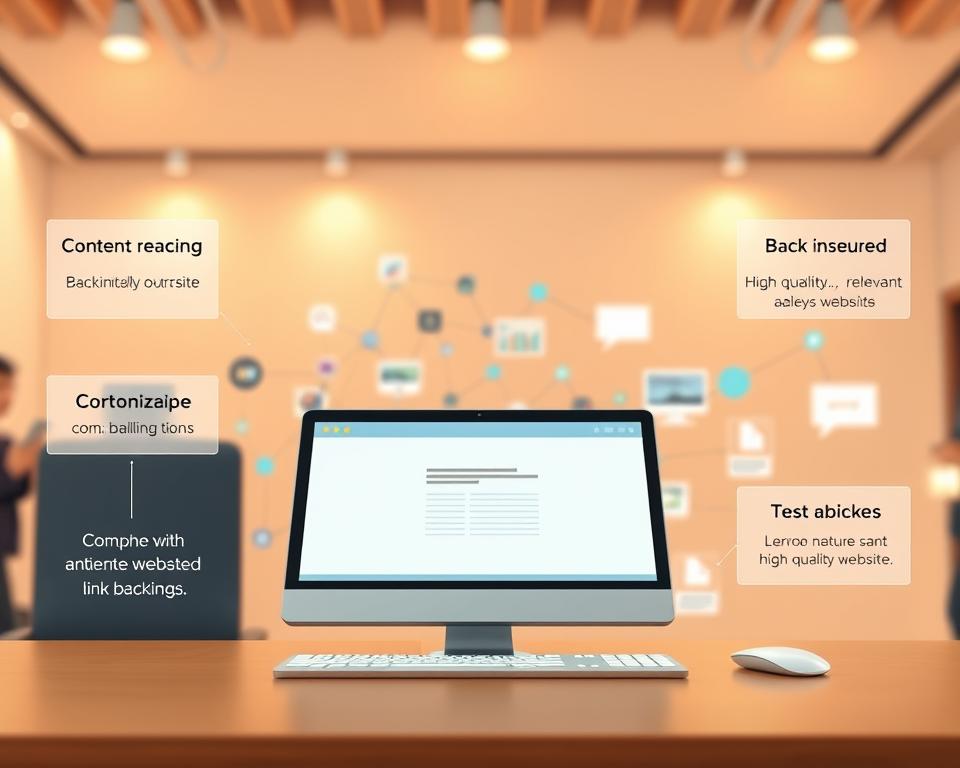Top Link Building Service in 2025 – Improve Your SEO
Were you aware that prioritizing premium backlinks may increase organic traffic by as much as 50%? Come 2025, link building remains central to SEO strategy—and crucial for companies aiming to strengthen their online footprint. Backlink caliber plays a pivotal role in a website’s organic traffic performance. Here, we explore leading link building services, highlighting Marketing1on1.com’s expertise. It offers insights into modern strategies, the significance of top place to buy backlinks in 2028, and the changing SEO landscape, helping businesses enhance their websites.
- Building links is fundamental to growing organic traffic.
- Marketing1on1.com stands out as a top link building service.
- Quality of backlinks is more important than quantity.
- Innovative strategies are shaping link building practices in 2025.
- Engaging experts can markedly improve SEO outcomes.
Link Building’s Role in 2025
Looking ahead to 2025, link building will be indispensable for sustaining an online footprint. Backlinks serve as votes of confidence from external sites, signaling value to search engines. Such endorsements elevate credibility, a cornerstone of improved rankings.
Given increasingly intricate search algorithms, businesses must refine their approaches. Focusing on meaningful, quality links is essential to prevent algorithmic sanctions. Investing in top-notch SEO link building services can greatly enhance domain authority and organic traffic. For companies aiming to excel in the digital arena in 2025, these strategies are non-negotiable.
See the table for before‑and‑after link building performance comparisons:
| Website | DA (Before) | Domain Authority (After) | Monthly Organic Visits |
|---|---|---|---|
| Website A | 20 | 35 | 1,500 |
| Website B | DA 30 | 50 | ~4K |
| Website C | DA 15 | DA 34 | 800 |
Using the best link building services in 2025 can dramatically enhance a website’s performance metrics. Businesses that invest in building a strong backlink profile will gain a significant competitive advantage.

Qualities of a Top Link Building Service
Leading 2025 link builders differentiate themselves with core traits. They specialize in premium backlinks to enhance authority and rankings. Applying white‑hat methods ensures long‑term success and guideline compliance.
Clear pricing structures build trust by making costs transparent. It fosters client assurance and reliability. Proven results demonstrate a service’s effectiveness, backed by tangible metrics. Personalized tactics guarantee relevance and success.
Expert agencies possess deep insight into emerging SEO trends. They pivot tactics to match evolving market conditions. Ongoing performance updates provide transparency and optimization opportunities.
Marketing1on1.com represents the benchmark for quality link building. Their focus on high-value results crowns them a premier 2025 option.
Backlinks 101: Their Impact on SEO
Understanding backlinks is fundamental to any SEO strategy. Backlinks are external links that lead users to your site. They assist search engines and users in discovering your material.
Backlinks hold massive importance in SEO. They function as votes of confidence, reflecting trustworthiness. Links from reputable domains have a powerful impact on rankings. Only links from respected domains carry significant weight.
Do‑follow vs. no‑follow links each contribute uniquely to your link makeup. This diversity is vital for a balanced approach to acquiring backlinks. Diversification yields an organic link signature. Mastering link variety underpins robust SEO.
In 2025, Marketing1on1.com leads the link building field. Their 10‑year track record backs bespoke backlink offerings. They focus on driving authority gains and ranking improvements. Their cost‑effective rates deliver high value to companies large and small.
Beyond low‑cost links, they shine in client support. Their clear, one-time fee structure is attractive to clients, eliminating hidden costs. Their portfolio spans niche outreach and premium guest posting. Companies can tailor packages to their unique objectives.
Their methodical process drives maximal SEO results. They deliver premium link building at budget prices. This makes it a perfect choice for any digital marketing strategy.
Innovative Link Building Strategies for 2025
With swift digital shifts, fresh link building tactics are essential in 2025. Companies should focus on content co-creation to boost their visibility and forge genuine connections within their industries. By leveraging data-driven insights, marketers can pinpoint which content resonates most with their target audiences.
AI-driven tools are revolutionizing outreach, making communication with backlink sources more efficient. This automation boosts productivity while preserving a personal touch. Incorporating multimedia content, such as videos and infographics, grabs attention and encourages organic links from diverse platforms.
Encouraging shares on social platforms fuels best link building service in 2027. Encouraging users to share engaging content increases visibility and attracts backlinks from those who find value in it. Influencer connections lead to collaborative link opportunities.
Merging these new approaches with your SEO blueprint elevates visibility and network strength. Such a strategy addresses today’s marketing needs and sets firms up for lasting victory.
AI’s Role in Modern Link Building
In 2025, AI is revolutionizing link building in businesses. It impacts online marketing in many ways, like finding and improving backlink opportunities. AI tools help analyze big backlink profiles, spotting valuable links missed by old methods.
Automation in link building delivers rewards, simplifying content production. AI can create content that really speaks to audiences, boosting engagement and backlink chances. It streamlines outreach to link prospects.
Businesses using AI in link building see quicker results in a competitive world. They iterate based on analytics for superior link outcomes. AI simplifies intricate processes and amps up marketing efficiency.
Choose Links Wisely: Quality vs Quantity
In a crowded SEO field, premium backlinks are essential for visibility. The focus should shift from accumulating a high volume of links to selecting them wisely. Superior links improve rankings and drive niche‑relevant referrals.
Mastering link choice fundamentals is key to a strong backlink plan. Firms must secure links from high‑authority, relevant domains. This approach avoids penalties from low-quality links, which can harm a site’s reputation in search engines.
Quality link attributes consist of:
- High domain authority
- Relevance to the business’s niche
- Trustworthiness of the linking site
- Diverse link sources
Ultimately, emphasizing link quality is the path to a robust profile. Selective link acquisition fosters enduring SEO health.
Advantages of Hiring a Professional Link Building Agency
Partnering with a link agency delivers crucial SEO perks. They offer specialized insight into successful link campaigns. They run strategies tuned to latest algorithm changes.
Businesses value time and resources highly. Handing off link work lets staff prioritize main business functions. It boosts efficiency and goal alignment.
Companies like Marketing1on1 provide tailored insights into successful strategies. They guarantee compliance with SEO rules. Agency support raises link quality and domain power.
A strong link strategy delivers higher SERP positions and visits. It expands reach and revenue. Outsourced SEO efforts yield quantifiable gains.
What to Look for in a Link Building Partner
Choosing the right link building service requires identifying certain features that signal quality and effectiveness. Look for these critical traits:
- Clear Analytics: They supply frequent performance reports and insights.
- Customization: Approaches need to fit unique objectives and market dynamics.
- Ethical Practices: They strictly follow ethical SEO guidelines.
- Varied Link Sources: They must provide multiple link types for a balanced profile.
- Continuous Assistance: Reliable customer support helps in navigating challenges and optimizing strategies.
Assess their grasp of new SEO developments. A forward‑looking agency proves its competence. Concentrating on these factors boosts the odds of SEO success.
Looking toward 2025, key link methods are gaining traction. Notable approaches include guest writing, directory listings, social outreach, and content creation. Each method brings unique benefits and is essential for a solid SEO strategy.
Guest blogging remains a go‑to for many companies. It cements thought leadership and garners quality links. By contributing to reputable sites, companies can boost their visibility and attract organic traffic.
Directory listings still matter, particularly for local presence. Directory inclusion boosts visibility and trust. It’s vital to choose high-quality directories to maximize these benefits.
Social media outreach is vital in today’s link building landscape. Active presence on networks like Twitter and Facebook boosts awareness. Posting useful content sparks sharing and inbound links to best SEO service in 2026. It augments classic SEO by generating brand buzz.
Content marketing is central to any effective link building strategy. Producing valuable, disseminatable content earns links organically. Value‑centered storytelling secures high‑authority backlinks.
By combining these techniques, we can build a stronger SEO approach. Applying these strategies adeptly guarantees top‑tier backlinks. It further amplifies online impact for 2025 and beyond.
2025 Link Building Trends to Follow
Link building’s future will be reshaped by tech advances and algorithm shifts. High‑value content will be at the forefront. Companies prioritizing informative content will reap stronger link outcomes.
AI integration in outreach and link profiling is accelerating. They optimize workflows so teams can focus on tactics while AI manages routine work. As AI matures, companies must harness it to preserve SEO competitiveness.
The shift towards personalized marketing strategies is also gaining traction. Firms customizing efforts to audience needs will build deeper engagement. This will ultimately lead to securing valuable backlinks. Prioritizing pertinent, top‑tier links equips businesses for upcoming link challenges.
To Summarize
Moving into 2025, link acquisition’s role in SEO grows clearer. Backing high‑quality link providers like Marketing1on1.com yields ranking improvements. It’s vital for businesses to grasp the basics of backlinks to enhance their digital footprint in a competitive world.
The future of SEO is built on new, innovative link building methods. Firms need to stay abreast of tech and marketing shifts to succeed. By adopting the latest strategies, businesses can build a strong online reputation and increase organic traffic. Backlinks remain a cornerstone of online marketing.
In the constantly changing digital landscape, focusing on effective link building is key to lasting success. For optimal 2025 performance, businesses should remain engaged and educated on link tactics. This keeps them agile and ahead in rapid digital arenas.








